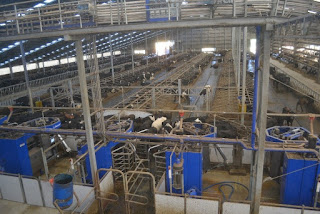Day 14
 |
|
Aerial view of the dairy barn
|
It was an exciting final day in New Zealand. This morning we
departed our hotel at 8:30 am for a very impressive robotic dairy. This was the
4th dairy we have seen since we landed here, but it was far different from any
of the others because it was much more similar to a North American style of
operation. Their animals were confined and fed a ration in a freestall barn
that consisted of corn silage, alfalfa silage, grass silage, and a mix of
canola, soy hulls, and other ingredients. The cows had mattresses to lay on and
all of the floors were covered in rubber. In addition to the robot milkers,
they also had automated manure scrapers to rid the barn of the “effluent” or
manure as we call it.
 |
|
Fresian cow standing on the rubber mat freestall bed, also
shown is manure scraper and rubber flooring
|
 |
|
Our Dairy Club Members Bennet, Katelyn, Kirby, Katelyn, and
Angel
|
Another difference from this dairy and the others that we
saw was that they do not do any bull breeding, they do all artificial
insemination. In their AI program, they are seeing success with 65% conception
rates in their herd. As for their production, they were currently milking 1400
cows, whose average ages are 7 years old, and last year they shipped a total of
800,000 kg of milk solids. The milk they were harvesting from the cows was 9%
solids (Fat+Protein). The robots were getting 1800 liters per day while
averaging 2.1 visits per cow across the entire herd. Over the course of a
lactation, their average “kiwi cross” (Jersey x Fresian) would produce 600 kg
of milk solids. This dairy was very impressive, we really enjoyed getting to
see robots work in a larger herd like this instead of the smaller herds we see
back home. This farm did have higher costs for producing milk, about $5.00/ kg
of milk solids, but they had much higher production than some others, and they
feel that the future of dairy farming in New Zealand will move away from
pasture systems due to environmental restrictions.
 |
|
This is what our group looks like when we are searching for
lunch….
|
After
leaving the dairy farm we headed to the town of Timaru for lunch and maybe do
some shopping. After all of the driving, we have had on this trip we all enjoy
our time off of the bus. Once everyone had eaten and seen the sites in Timaru,
it was on to the next farm.
 |
|
….and this is how we look once we have found our food
|
We
traveled to Orton to the crop farm that belonged to Raymond and James Bowan.
They farm 3,953 acres with 988 being wheat, 988 acres of feed barley, 617 acres
of potatoes, and 500 acres of grass seed production, with the remainder being
planted into fodder beet and kale. Their farm is 100% irrigated, and they pull
ground water for their irrigation, but have a 10 day backup supply if needed.
In their area, their annual rainfall is around 27 inches, but they can put down
about a quarter inch of irrigation down every day. The farm’s main product is
potatoes, and they grow two different varieties of potatoes, with one being for
potato fries production and the other being for potato chips.
 |
|
Cody enjoying some of the equipment at the Bowman farm
|
 |
|
Carrot harvest in progress
|
Once we
left our final farm tour of this amazing trip, we were on our way to
Christchurch for our final night in New Zealand. Once we got to Christchurch,
we drove though parts of town that were devastated by an earthquake back in
2011. This natural disaster killed 195 people, and damaged infrastructure that is
still being rebuilt and repaired to this day. We also went out to dinner at the
Pedal Pusher.



Great blog post and really helpful Midnightinfo | GATE 2018 , TANATA Result
ReplyDeleteWe offer financial assistance services to all individuals around the world.
ReplyDeletePlease, contact us if you are in need:
E-mail: info@creditfinance-bank.com
Whatsapp number: 33784505888
Website: https://www.creditfinance-bank.com
You are one of the best bloggers on this platform, and I am very thankful to you for sharing this information with all blog readers. We are a tour and travel company. For Tour and Travel packages, Please visit our website. best dmc for bali
ReplyDeleteOfficial dmc for bali
official dmc of bali
dmc of bali
top dmc in bali
bali dmc in india
bali dmc in delhi
dmc of bali in mumbai
top list of bali dmc
official bali dmc in india
bali dmc in kolkata
bali dmc in banglore
balidmc in surat
bali dmc in gujrat
bali dmc in ahemdabad
bali dmc in punjab
dmc of bali in mumbai